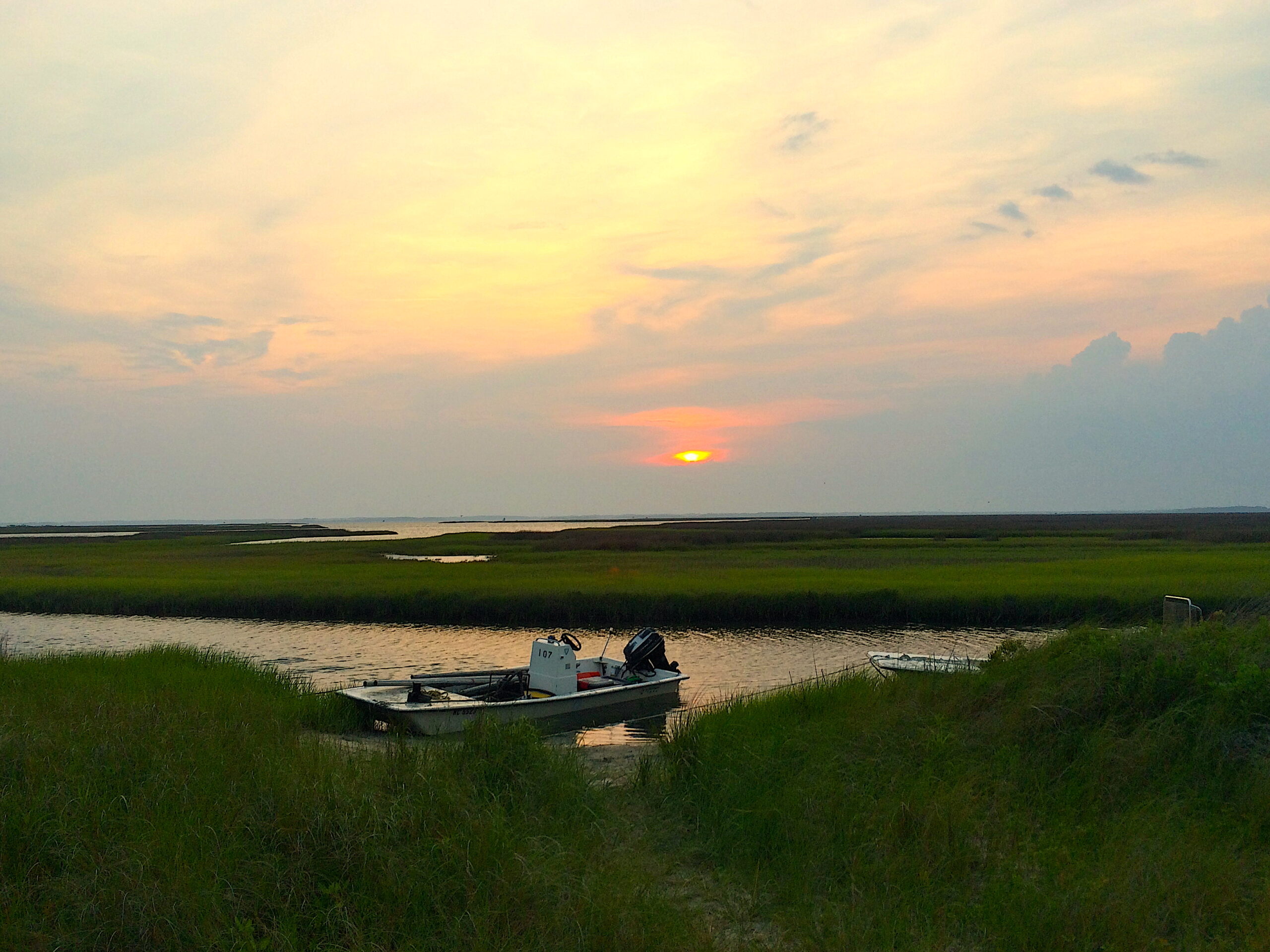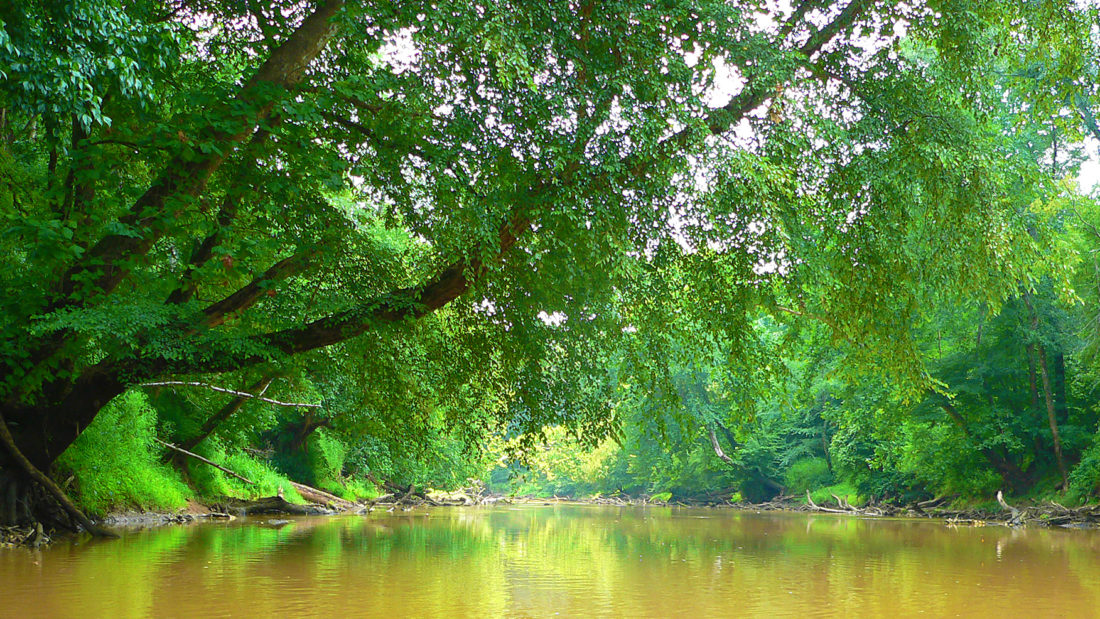Teacher Marlene Stalls asks a group of eighth-graders scattered across a large garden near the school parking lot to describe their latest lesson.
“Alligator weeds are bad!” they shout, as they pull up handfuls of the weeds and collect them in a bin. Pulling weeds in one of Manteo Middle School’s two rain gardens is how the students spend some of their “Braves” time — a period nicknamed for the school’s mascot — when students get an extra dose of physical activity each week.
The rain gardens at Manteo Middle, planted in 2006, are just one schoolyard project started through funding by the Albemarle-Pamlico National Estuary Program.
In 2005-2006, APNEP funded approximately $225,000 for 14 projects that would benefit the environment, fit with teaching curriculum and could easily be continued by the schools after funds were spent.
Manteo Middle is one stand-out example of the ongoing growth and success from the cultivation of those first seeds. APNEP expects to fund a new round of demonstration projects at the end of this year.
After listening to guest instructors Kathy Mitchell and Sara Hallas give a quick lesson on the alligator weed, an invasive species found in marshes, the kids scatter to look for the characteristic spreading vines and shiny leaves.
“Look how long the roots are,” says one student, holding up a weed for Stalls to see “What about this one?” another student asks, pointing to a tall, thin, furry-looking plant. “That’s dog fennel,” Mitchell says, wrinkling her nose. “We don’t want that. Pull it up.”
Mitchell, a horticulturist at the N.C. Aquarium at Roanoke Island, helped design the rain gardens with native plant species like Carolina willow and sweet pepperbush. Plants were chosen for their durability, value as wildlife food sources and habitats, and for aesthetic value.
According to Hallas, an education specialist with the N.C. Coastal Federation, storm water runoff is the number one source of water pollution in the state. Rain gardens filter runoff from paved surfaces and reduce pollution entering storm drains.
Hallas is customizing lessons to promote coastal education and fit within state-required curriculum. Hallas and teacher Mary Ann Hodges envision a field guide with pictures of the plants in the rain gardens. Photos of the plants at different stages of development will help the students and teachers identify and weed out invaders, but keep appropriate plants.
“The kids start to recognize these plants in other places,” says Hodges, who teaches seventh-and eighth-graders. “It’s extremely important for this age group to be able to relate what they learn to something in real life,”
Hodges has been at Manteo Middle since it moved to its new location in January 2006. She thinks the rain gardens have helped show community members that Manteo Middle is taking steps to minimize the school’s ecological footprint.
Hodges is pleased with the amount of community involvement and support they have seen since the rain gardens were planted. “Local people are happy to come in and share their specialties.”
Other partners on the project included the University of North Carolina Coastal Studies Institute, N.C. Cooperative Extension Master Gardener volunteers, other local volunteers and parents.
SOLITE SOLUTION
On a gray morning in Edenton, when the clouds threaten that the sky is about to open up, Steve Karl points out two storm drains on opposite sides of John A. Holmes High School’s front lawn.
One of the drains is just a grate in a small depression in the grass. The other is surrounded by a small rain garden with a gravel border. A sign in front of the second drain shows results from the storm water demonstration project funded by APNER which Karl directed and students designed and built.
According to Karl, a teacher at Holmes High for 27 years, Edenton receives big rains several times a year, sometimes as much as four to six inches in a single storm. “There’s nowhere for the water to go,” Karl says. Nowhere except into storm sewers that wash pollutants and excess nutrients into a waterway that leads to Edenton Bay, a picturesque part of the historic town. “We’re trying to decrease or eliminate water going into storm sewers.”
To do this, Karl and his students decided to dig a 12-by-12 foot square pit around one of the existing drains and fill it with an absorptive material, to draw water back into the ground instead of letting it flow freely into the storm drain. The other drain remained unmodified to serve as a “control.”
Karl and his students researched materials and found that a lightweight aggregate shale, called “solite” absorbed 20 percent more water than anything else they tested. Holmes High bought 12 tons of the porous rock and filled the square pit dug by the students.
After investigating to find the best plant species for their purpose, the students planted a small rain garden on top of the solite. An eight-inch border of the solite gravel surrounds the rain garden and connects to the deeper layer below, capturing water at the surface and soaking it down.
To monitor how well this model would work, Karl and the students installed durable flow meters with ultrasonic sensors in the experimental drain and the control drain. The meters measured the flow of water through the drains in gallons per minute.
Data from May 2007 flow meter readings showed that on days with the most rain, the amount of water flowing into the modified storm drain was reduced by up to 95 percent compared to the control. During one particular rain on May 7, 2007, the maximum flow recorded in the control drain was 171 gallons per minute — but only 11 gallons per minute in the modified system.
Students Tyron Bowser, Ashleigh Perry, Austin Hale and Myron Brown stand beside the rain garden and remember all the work they put into it during the 2005-2006 school year. They note how much better it looks now that the liriope and other perennial plants are established and thriving.
“It wasn’t so pretty when we were working on it,” Brown recalls. Although they groan as they remember all the digging, concrete mixing and shoveling, the students show pride in what the project is today. “It’s a reflection of hard work,” Bowser says.
Karl continues to take his earth science classes out to take readings from the flow meters as they study the water cycle. One senior also used the meters for an engineering project on hydrology.
APNEP mandated specific criteria for schoolyard projects to receive funding. Projects had to be on or adjacent to school property, have a physical structure, have an educational/public outreach component, be accessible to the public, and have methods to transfer responsibility into schools’ hands.
“We wanted the projects to have long-term lasting effects in communities,” says Bill Crowell, director of APNEP. The program covers 36 northeastern North Carolina counties and 19 counties and incorporated cities in southeastern Virginia. The Virginia communities are within watersheds that drain to the Albemarle-Pamlico coastal waters.
Crowell says that APNEP is excited that many schools have maximized their funds by involving partners. He proudly describes one case where a seventh-grader at J.E.J. Moore Middle School in Prince George County, Va., secured a donation of all the gravel needed for a nature trail and outdoor classroom from the Vulcan Materials Company.
“A 12-year old girl got $50,000 of material for free!” In addition to students, teachers, parents and community members, the Moore Middle project involved a number of partners: USDA’s Natural Resources Conservation Service (NRCS), the James River Soil and Water District, the Virginia Department of Forestry, the Friends of the Lower Appomattox River and the National Park Service.
Teacher Holly Boyd integrated the development of the 30,000-foot trail into the theme of problem solving with her gifted/exploratory class. Students were split into groups where they researched handicapped access, gravel and bench design. Then each group submitted a proposal.
“We worked three months in the rain and snow to get it done,” Boyd remembers. Teachers gave up Saturdays and Sundays to work on the outdoor classroom, which has a kiosk and whiteboard for teachers and community members to use for lessons and information sessions.
Other community members caught on to their enthusiasm and pitched in to help. Two Boy Scouts working on their Eagle Scout projects built the benches for the outdoor classroom. Volunteers from the local Rowanty Vocational Technical Center built two bridges to cross over wetland areas.
“One sixth-grader decided last year that the trail needed bird houses, and he and his grandfather built 12 and put them along the trail,” Boyd says. The trail is even used for themed scavenger hunts and elementary school field trips, when sixth graders get to be the experts and share their knowledge of the outdoors with the younger students.
LEADING BY EXAMPLE
Many of the participating teachers hope their APNEP projects inspire similar efforts at other schools.
Karl at Holmes High emphasizes that anyone can feasibly reduce storm water run-off through low-impact development methods. It could be something as simple as using absorptive materials such as gravel instead of pavement for a driveway.
Hodges at Manteo Middle is developing lesson plans that other teachers can integrate with a rain garden, covering a variety of subjects. For science, lessons will cover soil, water, weather and volunteer plants. Math will cover ratios of desirable versus undesirable plants, population studies and graphing the results. And for social studies, lessons cover origins of plants, maps and how humans have interacted with plants throughout history.
Moore Middle held a daylong summer “staff development” workshop for teachers to experience the trail and outdoor classroom and to come up with their own ideas for lesson plans.
“People from surrounding counties have shown interest and walked the trail, saying they want to do the same thing,” Boyd says. Moore Middle School received an award for their nature trail in Spring 2007 from the South Centre Corridors Resource Conservation and Development Council for exemplary assistance to the program by an individual or organization.
Manteo Middle School received a 2006 Pelican Award for Environmental Education from the N.C. Coastal Federation for their rain gardens.
APNEP partners are the U.S. Environmental Protection Agency, N,C. Department of Environment and Natural Resources and Virginia Department of Conservation and Recreation. The APNEP region includes the Chowan, Pasquotank, Roanoke, Tar-Pamlico and Neuse river basins. Jack Thigpen, North Carolina Sea Grant extension director, chairs the APNEP Policy Board.
The APNEP Citizens’ Advisory Committee decide whether new funding will go towards school-based projects or projects in other focus areas.
For more information on these or other APNEP projects, visit the APNEP website.
This article was published in the Autumn 2008 issue of Coastwatch.
For contact information and reprint requests, visit ncseagrant.ncsu.edu/coastwatch/contact/.



